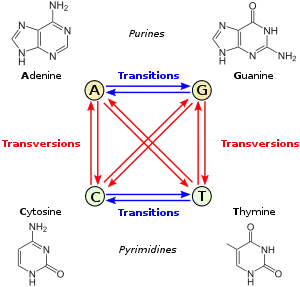Transition (genetics)
Transition, in genetics and molecular biology, refers to a point mutation that changes a purine nucleotide to another purine (A ↔ G), or a pyrimidine nucleotide to another pyrimidine (C ↔ T). Approximately two out of three single nucleotide polymorphisms (SNPs) are transitions.[1]

Illustration of a transition: each of the 4 nucleotide changes between purines or between pyrimidines (in blue). The 8 other changes are transversions (in red).
Transitions can be caused by oxidative deamination and tautomerization. Although there are twice as many possible transversions, transitions appear more often in genomes, possibly due to the molecular mechanisms that generate them.[2]
5-Methylcytosine is more prone to transition than unmethylated cytosine, due to spontaneous deamination. This mechanism is important because it dictates the rarity of CpG islands.
See also
References
- Collins DW, Jukes TH (April 1994). "Rates of transition and transversion in coding sequences since the human-rodent divergence". Genomics. 20 (3): 386–96. doi:10.1006/geno.1994.1192. PMID 8034311.
- Ebersberger I, Metzler D, Schwarz C, Pääbo S (June 2002). "Genomewide comparison of DNA sequences between humans and chimpanzees". Am. J. Hum. Genet. 70 (6): 1490–7. doi:10.1086/340787. PMC 379137. PMID 11992255.
This article is issued from Wikipedia. The text is licensed under Creative Commons - Attribution - Sharealike. Additional terms may apply for the media files.